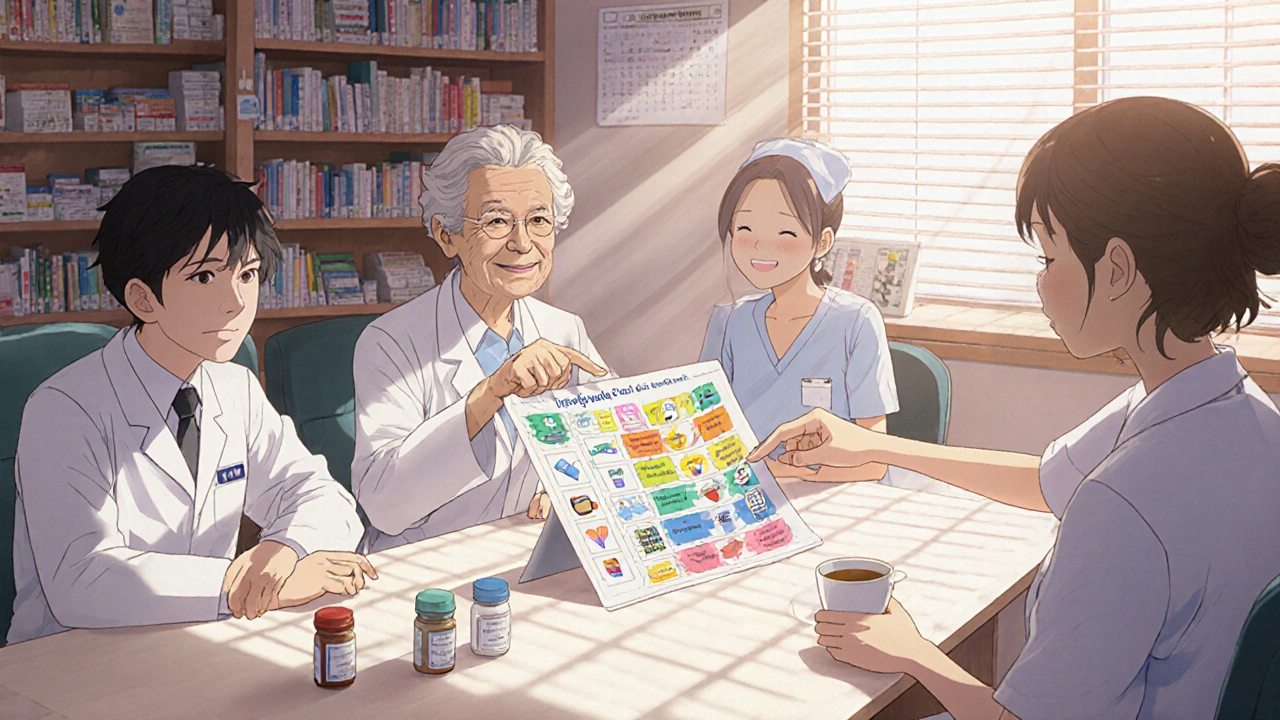Getting your medications right isn’t just about picking up prescriptions. It’s about knowing when to take them, why you’re taking them, and what to do if something goes wrong. Too many people end up confused, overwhelmed, or even hospitalized because their medication routine doesn’t match their real life. That’s where a Medication Action Plan (MAP) comes in. It’s not a list. It’s a living guide you build with your care team to make sure your meds work for you-not the other way around.
What Is a Medication Action Plan?
A Medication Action Plan is a personalized document that turns your medication list into clear, doable steps. Unlike a simple pharmacy label or a handwritten note, it includes specific actions tied to your daily routine, goals, and concerns. It’s part of a broader system called Medication Therapy Management (MTM), which has been required for Medicare Part D beneficiaries since 2006. In Germany, since 2016, patients taking three or more prescribed medicines are legally entitled to a standardized medication plan updated by their pharmacist each time they pick up a new prescription.The goal? Reduce errors, prevent hospital visits, and help you stick to your regimen. Studies show that when patients help create their own MAP, adherence improves by 25-40%. For someone managing diabetes, heart disease, and high blood pressure, that’s the difference between staying out of the ER and living well.
Who’s on Your Care Team?
You’re not alone in this. A Medication Action Plan is a team effort. Your team includes:- Your doctor - who prescribes your meds and adjusts doses based on how you’re doing
- Your pharmacist - who knows how drugs interact, catches duplicates, and can explain side effects in plain language
- Your nurse or care coordinator - who helps track progress and connects you to resources
- Family members or caregivers - who can remind you, help you organize pills, or spot changes in how you feel
Don’t forget: you are the most important member. Only you know if taking a pill after breakfast actually works with your schedule, or if the side effect you’re ignoring is worse than the condition you’re treating. Your input isn’t optional-it’s essential.
How to Prepare for Your Medication Review
Before you sit down with your care team, gather everything. Don’t rely on memory. Bring:- All prescription bottles - even ones you haven’t used in months
- All over-the-counter meds - painkillers, sleep aids, antacids
- Vitamins, supplements, and herbal products - yes, even the “natural” ones
- A list of any symptoms you’ve noticed - dizziness, nausea, fatigue, confusion
- Your biggest frustrations - “I always forget my afternoon pill,” or “I don’t know why I’m taking this one”
This is called a Comprehensive Medication Review (CMR). It usually takes 30 to 60 minutes. Pharmacies, clinics, and even telehealth services offer these. If your doctor doesn’t mention it, ask: “Can we do a full medication review?”
Building Your Action Plan: Step by Step
Once your team has a full picture, you’ll build your plan together. Here’s how it works:- Clarify each medication’s purpose. Don’t just know the name-know why you take it. “I take lisinopril to lower my blood pressure and protect my kidneys.” If you can’t say that, ask again.
- Identify problems. Are you skipping doses? Mixing up morning and night pills? Avoiding meds because of side effects? Your team will list these as specific issues.
- Set one or two realistic goals. Start small. “Take my morning pill every day for the next 30 days” is better than “Take all meds perfectly.”
- Match actions to your life. If you brush your teeth at 7 a.m., put your morning pills next to your toothbrush. If you eat dinner at 6 p.m., use your dinner plate as a reminder. One patient turned her MAP into a visual chart with photos of her pills next to her coffee cup, toothbrush, and TV remote. Her adherence jumped from 65% to 95%.
- Plan for “what if” moments. What if you miss a dose? What if you feel dizzy after taking your blood pressure pill? Your plan should include simple instructions: “If I feel lightheaded, sit down and call my pharmacist. Do not take an extra pill.”
- Write it down-clearly. No medical jargon. Use bullet points, icons, or color codes. If you’re blind or have low vision, ask for a version with large print or audio reminders.

What Makes a Good Medication Action Plan?
Not all plans are created equal. The best ones have three things:- Personalization. A pre-printed template won’t help if it doesn’t fit your schedule, reading level, or lifestyle. A Johns Hopkins study found generic plans had zero impact on adherence.
- Clear, simple language. “Take 10 mg once daily” is fine. “Administer 10 mg PO QD” is not. Ask your pharmacist to translate any confusing terms.
- Measurable goals. “Improve adherence” is vague. “Take all morning meds correctly 6 out of 7 days per week for the next month” is trackable.
And it’s not a one-time thing. Your plan should be reviewed every 3 to 6 months-or anytime your meds change, your health shifts, or you start feeling different.
What If You’re Not Getting a Plan?
Many people never get one-even if they qualify. In a 2022 study, 43% of eligible patients said they’d never received a written action plan. Here’s what to do:- If you’re on Medicare Part D and take 5+ chronic medications (as of 2024), you’re eligible for free MTM services. Call your plan or pharmacy.
- If you’re not on Medicare, ask your doctor or pharmacist: “Do you offer Medication Therapy Management?” Many private insurers now cover it.
- If you’re told “no,” ask for a copy of your Personal Medication Record (PMR)-a full list of everything you take. You can turn that into your own plan.
Some pharmacies, like CVS and Walgreens, offer free medication reviews. You don’t need an appointment. Just walk in with your meds.
Technology Can Help-But Don’t Rely on It Alone
There are apps that send pill reminders, track doses, and even alert your pharmacist if you miss a dose. Many pharmacy chains now offer these for free. But apps aren’t magic. If the app doesn’t match your actual routine, you’ll ignore it.The best tech works with your plan. For example: if your MAP says “Take metformin with breakfast,” set your phone alert for 8 a.m. every day, not just “take pill.” And make sure your care team knows about your app-so they can adjust the plan if it’s not working.
Real Results, Real Stories
One 72-year-old man in Bristol took 11 different medications. He couldn’t remember which was for his heart, which was for his joints, or why he felt so tired. After a 45-minute review with his pharmacist, they cut two unnecessary pills, combined two others, and created a simple color-coded chart: red for morning, blue for evening, green for as-needed. Within two weeks, his energy improved. Three months later, his blood pressure was in range-and he hadn’t visited the ER in a year.Another woman with diabetes skipped her insulin because she hated the needles. Her MAP didn’t just say “take insulin.” It said: “Use your pen at the kitchen table after brushing your teeth. Reward yourself with a cup of tea afterward.” That small change made all the difference.
What to Do Next
Start today:- Collect every medication you take-prescription, OTC, supplements.
- Write down your top two frustrations with your meds.
- Call your pharmacy or doctor’s office and ask: “Can we schedule a Medication Therapy Review?”
- Bring your list and your concerns to the appointment.
- Ask for a copy of your Medication Action Plan-and keep it where you’ll see it every day.
Medications are powerful tools. But they only work if you can use them. A Medication Action Plan isn’t paperwork-it’s your roadmap to feeling better, staying safe, and taking control.
What’s the difference between a medication list and a Medication Action Plan?
A medication list just shows what you take-names, doses, times. A Medication Action Plan goes further: it explains why you take each one, identifies problems you’re having, and gives you specific, personalized steps to fix them. It turns information into action.
Do I need to be on Medicare to get a Medication Action Plan?
No. While Medicare Part D requires plans to offer Medication Therapy Management to eligible members (those taking 5+ chronic meds), many private insurers, employer plans, and community pharmacies now offer free medication reviews too. Ask your pharmacist or doctor-they may already be offering it.
Can I create my own Medication Action Plan without a care team?
You can start one on your own using a template or app, but it won’t be as safe or effective. Only your care team can spot dangerous interactions, stop unnecessary meds, or adjust doses. A self-made plan might miss critical risks. Always involve your pharmacist or doctor to review and approve it.
What if I don’t understand the medical terms on my plan?
Ask for a plain-language version. Say: “I need this in words I can understand.” Pharmacists are trained to explain meds without jargon. If they don’t offer it, ask to speak with someone who does. Your plan should never require a medical degree to follow.
How often should I update my Medication Action Plan?
Update it every 3 to 6 months-or anytime you start or stop a medication, change your dose, or notice new side effects. Also update it if your daily routine changes-like retiring, moving, or starting a new job. Your plan should grow with your life.
Can my family help with my Medication Action Plan?
Yes-especially if you have memory issues, vision problems, or live alone. Bring a family member to your review. Ask them to help you track doses, set reminders, or spot changes in how you feel. Many successful plans include a trusted person as a backup contact.
Troubleshooting Common Issues
- “I forget to take my pills.” Try a pill organizer with alarms, or link doses to daily habits (e.g., “after I brush my teeth”).
- “The plan is too complicated.” Ask for a simplified version. Use colors, pictures, or a voice note.
- “My doctor and pharmacist give me different advice.” Bring both to the same appointment. Ask them to talk together. Your plan should be consistent.
- “I don’t want to take this medicine.” Don’t skip it-talk about it. Maybe there’s a better option. Your plan should reflect your concerns, not just your prescriptions.
If your plan isn’t working, it’s not your fault. It’s a sign it needs to be rewritten. Keep asking until it fits your life.







Comments
Jessica Healey
i used to forget my meds until i started putting my pills next to my coffee mug. now i take them every morning while waiting for my brew. it’s stupid simple but it works. no app, no fancy chart-just coffee and consistency.
Levi Hobbs
This is such a vital topic-and so under-discussed! I’ve seen elderly relatives get hospitalized because they were taking two different blood pressure pills that did the same thing. The key is the pharmacist involvement. Most people don’t realize pharmacists are trained to catch these interactions. If your doctor doesn’t mention a medication review, just ask. It’s literally free for Medicare Part D folks. I wish more people knew this.
henry mariono
I’ve been managing three chronic conditions for five years now. I used to just rely on the pharmacy label. Then I sat down with my pharmacist, wrote out my daily routine, and matched pills to habits-brushing teeth, lunch, bedtime. Now I have a laminated card in my wallet. No one ever asks me about it. But I know it’s saved me from ER trips. Small changes. Big results.
Sridhar Suvarna
In India we don’t have formal MAP systems but my uncle who takes 8 medicines started using a color-coded pillbox with pictures of his food. Red for breakfast, yellow for lunch. His daughter took a photo of each pill next to his chai cup. Now he never misses a dose. It’s not high tech. It’s human. The real innovation is listening to the patient not just prescribing to them.
Joseph Peel
There’s a reason this works. It’s not about technology. It’s about agency. When patients are included in designing their own care, they stop being passive recipients and become active managers. That shift-from compliance to collaboration-is the real breakthrough. And it’s not just for seniors. Young adults with autoimmune diseases need this too. The system isn’t built for it yet. But individuals can demand it.
Kelsey Robertson
Oh please. Another ‘personalized plan’ fantasy. You think a color-coded chart is going to fix a system that forces people to take 12 pills a day just because Big Pharma made 12 different versions of the same drug? This is band-aid medicine. The real problem? Over-prescribing. And no one’s talking about that. They’re just teaching people how to survive the chaos they created.
Joseph Townsend
My grandma had a MAP. It was handwritten on a napkin from the diner, taped to the fridge with a magnet shaped like a cat. She had red for morning, blue for night, and a little star next to the pill she hated. She’d say, ‘If I take this one, I get to eat the chocolate chip cookie.’ And guess what? She took it. Every. Single. Day. That’s not medicine. That’s magic. And it’s cheaper than any app.
Bill Machi
Let’s be real-this is just another bureaucratic hoop for Americans to jump through. We’ve got a healthcare system that treats pills like candy and patients like problems to manage. You want better adherence? Fix the pricing. Fix the complexity. Stop forcing seniors to choose between insulin and rent. A color-coded chart won’t fix that. And don’t pretend it will.
Elia DOnald Maluleke
In South Africa, we call this ‘ubuntu’-I am because we are. My mother took five meds. She couldn’t read. So her neighbor, who worked at the clinic, came every Sunday. They sat together. She pointed. Her neighbor wrote in Zulu. They drew a sun for morning, a moon for night. No doctor needed. Just community. This isn’t innovation. It’s dignity. And it’s been done for centuries-just not in white coat offices.
satya pradeep
My dad took 9 pills daily and forgot half of them. I made a WhatsApp group with his pharmacist, his doctor, and me. Every Sunday he sends a photo of his pillbox. If something’s missing, the pharmacist calls him. No app. Just a group chat. He’s been stable for 8 months. Simple. Human. Works. Why do we overcomplicate everything?
Shannon Hale
Oh wow, look at this-another feel-good article that ignores the real issue: doctors don’t have time, pharmacists are overworked, and patients are treated like dumb kids who need a sticker chart. This isn’t empowerment-it’s patronizing. If your plan requires you to link pills to your toothbrush, maybe you shouldn’t be taking so many damn pills in the first place.
Holli Yancey
I love how this post says ‘you’re the most important member’-but then spends 1,000 words telling you exactly how to do it. Why not just say: ‘Talk to your pharmacist. Ask questions. Don’t be shy.’ That’s all you need. The rest is just noise.